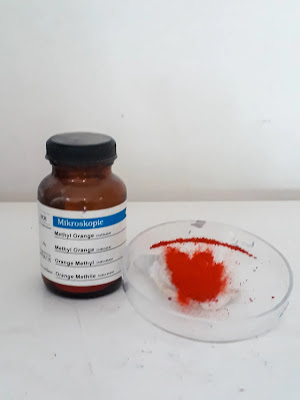Contents
hide
General Information
- Read – Guidelines for Handling and Storage – Methyl Orange SDS!
- Product Name: Methyl Orange.
- Signal sign: Danger!
- Synonyms: C.I. Acid Orange 3, C.I. 14700, Methyl Orange B Base.
- CAS Number: 547-58-0.
- EINECS Number: 208-828-9.
- Component Name: Methyl Orange.
- Formula: C14H15N3O3SNa
- Formula Wt.: 327.334
- Synonyms: Sodium p-dimethylaminoazobenzenesulfonate; C.I. 13025
First-Aid Measures
If inhaled: Remove the victim to fresh air & keep them at rest in a breathing-friendly position.
If in the eyes: Carefully rinse for a few minutes with water. If contact lenses are present and simple to remove, do so. Rinsing continues.
If on the skin: thoroughly rinse with water.
If Swallowed: Rinse mouth if swallowed, Call a doctor or a poison control centre right away.
Hazards Identification
- Hazard class: Acute toxicity, oral
- Skin Irritation: Not classified.
- Eye Irritation: Not classified.
- Sensitization: Not classified.
- Carcinogenicity: Not classified.
- Reproductive Toxicity: Not classified.
- Specific Target Organ Toxicity (Single Exposure): Not classified.
- Specific Target Organ Toxicity (Repeated Exposure): Not classified.
- Aspiration Hazard: Not classified.
- If swallowed: It is Toxic.
- Avoid eating, drinking, and smoking while taking this product.
Handling & Storage
- Store the container in a cool, dry area with the lid well closed.
- Store with stains, colors, & indicators.
- Stay away from the skin & eyes.
- Utilize sufficient ventilation.
- After handling, carefully wash your hands.
Exposure Controls/Personal Protection
- To avoid skin & eye contact, put on the proper protective gloves, clothes, and eye/face protection.
Accidental Release Measures
- Put on the proper personal protection gear.
- Avoid breathing in any mist or particles.
- Spills should be swept up or vacuumed up and put in an appropriate receptacle for disposal.
Fire-Fighting Measures
- Not deemed to be a fire threat.
- Not considered to be an explosive threat.
- Not considered to be a health risk.
- To put out fires, use water spray, foam, dry chemicals, or carbon dioxide.
Physical & Chemical Properties
- Appearance: orange powder.
- Odor: Burnt rubber-like odor.
- pH(indicator): 3.0 red through 4.4 yellow.
- Melting Point: Not available.
- Boiling Point: Not available.
- Flash Point: Not available.
- Evaporation Rate: Not available.
- Flammability: Not available.
- Upper/Lower Flammability or Explosive Limits: Not available.
- Vapor Pressure: Not available.
- Vapor Density: Not available.
- Solubility: Soluble in hot water & partially soluble in alcohol.
- Specific Gravity: Not available.
Stability & Reactivity
- Stable under typical circumstances.
- Strong acids & oxidizing agents are incompatible with each other.
Toxicological Information
- Acute effects: Harmful if swallowed.
- Chronic effects: N.A.
- Target organs: N.A.
- LD50 for ORL-RAT: 60 mg/kg
- LC50 for IHL-RAT: N.A.
- LD50 for SKN-RBT: N.A.
Ecological Information
- Not available.
Disposal Considerations
- Follow all local, state, and federal requirements when disposing of materials.
Transport Information
- Hazard class: 6.1, Keep away from food; shipping name: Toxic Solids, Organic, N.O.S.; UN number: UN2811
Regulatory Information
TSCA and EINECS listings (208-925-3).
Other Information
This Methyl Orange SDS is intended as a guide & is based on data & tests that are likely to be reliable. I don’t guarantee the data’s correctness or completeness & I’m not responsible for any resulting losses. The information is only being provided for your review, research, & verification. I DO NOT ASSUME RESPONSIBILITY AND EXPRESSLY DISCLAIM LIABILITY FOR LOSS, DAMAGE, OR EXPENSE RESULTING FROM OR IN ANY WAY CONNECTED WITH THE HANDLING, STORAGE, USE, OR DISPOSAL OF THIS PRODUCT FOR THE FOREGOING AND OTHER REASONS.

Methyl Orange is an indicator dye that adapts its hue to a solution’s pH level. It is frequently employed in titrations and in laboratory research as a pH indicator.
Conclusion
Methyl Orange is an indicator dye that adapts its hue to a solution’s pH level. It is not regarded as a dangerous material &, when handled appropriately, does not present a serious risk to one’s health or safety. To avoid skin and eye contact, it’s crucial to use the appropriate personal protective equipment & adhere to correct handling and storage techniques. The substance should be handled in a cold, dry environment & disposed of in compliance with all applicable federal, state, & local laws. Always follow Methyl Orange SDS!
